Metro Makes Long-Needed Changes at 18th & Clark, Still Violates ADA
In a couple of weeks Metro’s new North County Transit Center will open, so many MetroBus routes will see major changes:
Metro’s quarterly service change on March 14 will impact the operations of 48 MetroBus routes in the St. Louis metropolitan region, including the introduction of nine new MetroBus routes and discontinuation of service on eight routes. This service change will also introduce a new and completely redesigned MetroBus service plan for North St. Louis County, made possible with the opening of the new North County Transit Center in Ferguson, Missouri on March 14. (Metro)
On that same day, changes will take place in downtown (technically Downtown West):
The Civic Center Transit Center is scheduled to be closed down for construction activity shortly, at a date to be decided. In advance of the closure, Metro has prepared bus stops at 18th Street & Clark Street, adjacent to the Union Station MetroLink, to provide the same system connectivity.
The routing and schedules of the routes serving the Civic Center Transit Center have been modified to serve 18th Street & Clark Street to ensure the same connections with the other MetroBus routes and MetroLink at Union Station instead.
Please note that till the closure of the Civic Center Transit Center, these routes will continue to serve the Civic Center Transit Center. Public Announcement of the closure of the Civic Center Transit Center will be made in advance of the event. (Metro)
The following MetroBus routes will change to include 18th & Clark.
- 10 Chippewa
- 32 ML King-Chouteau
- 41 Lee
- 73 Carondelet
- 80 Park-Shaw
- 94 Page
- 97 Delmar
- 99 Downtown Trolley
- 40X I-55 Express
- 58X Twin Oaks Express
- 410X Eureka Express
When I need to catch the #10 Westbound I do so at 16th & Olive, but starting March 14th it’ll use 18th rather than 14th Street. Same goes for the #97 — I usually catch it at 16th & Washington but it’ll turn on 18th. Those who ride the #94 & #97 to Washington & 14th, then catch the #99 Downtown Trolley to take them the rest of the way into the Central Business District (CBD), will need to figure out an alternates. Perhaps catching the Trolley bus at Civic Center/18th & Clark? That’ll require more time though — years ago more bus routes entered the CBD.
For a few months now I’ve been watching the changes at 18th & Clark. I posted about the upcoming Civic Center changes in 2014, see Civic Center Transit Center Sans Trees, Awaiting Redo.
Before I get into the recent changes along Clark I want to show you the before conditions, in October 2011 & August 2012.
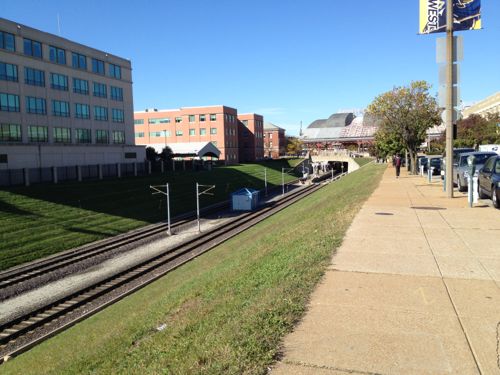
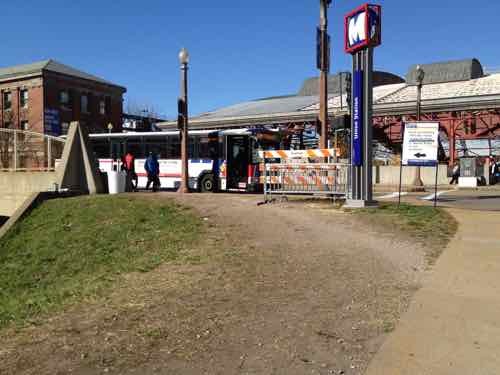
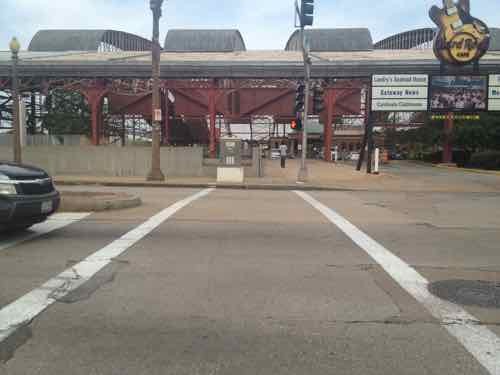
Ok, so now you’ve seen the before. In December last year I began seeing work going on so I braved the cold one day to get some pics:
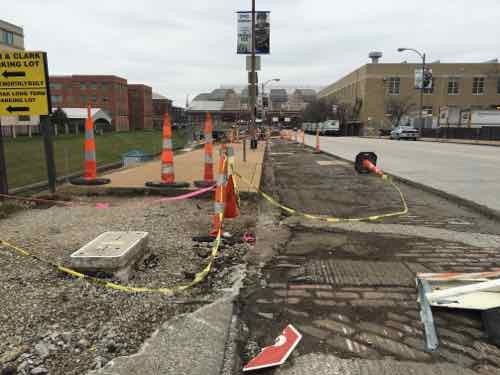
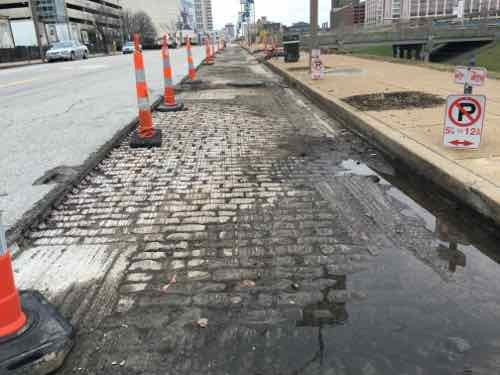
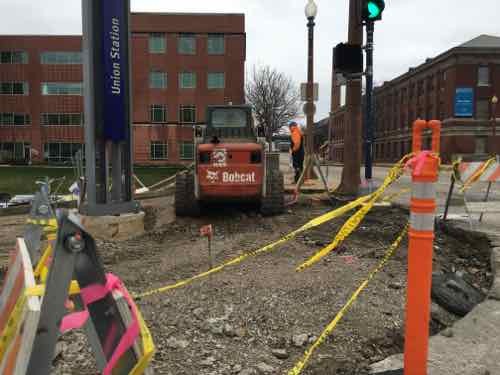
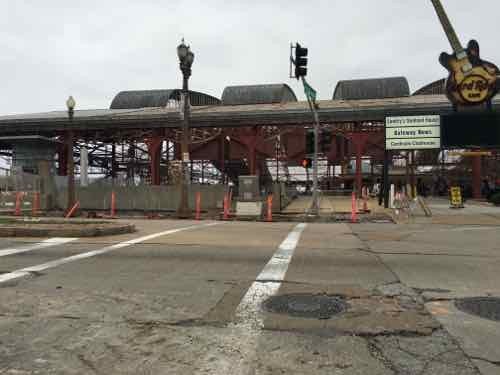
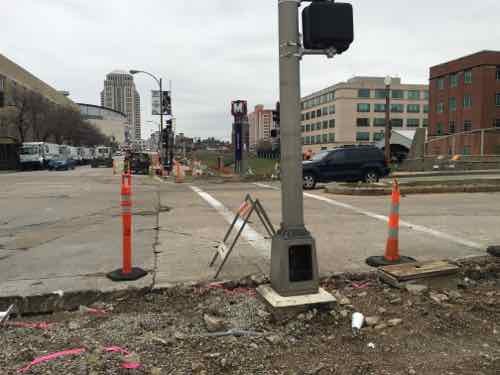
I was encouraged seeing the West end of the crosswalk completely removed — a fresh start so it’ll be done correctly! I returned a month later, in late January:
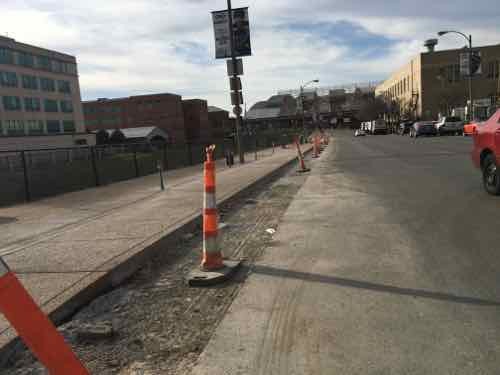
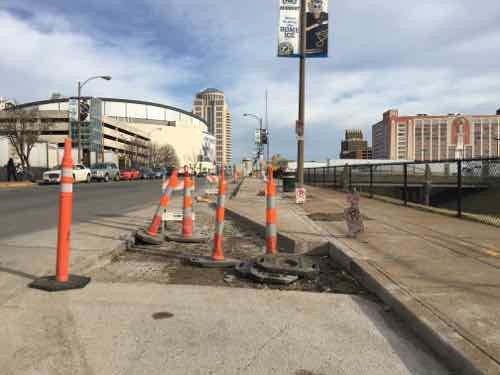
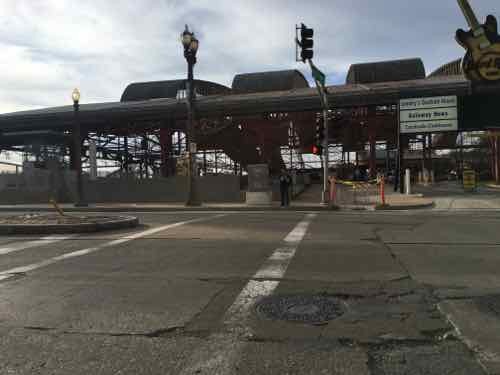
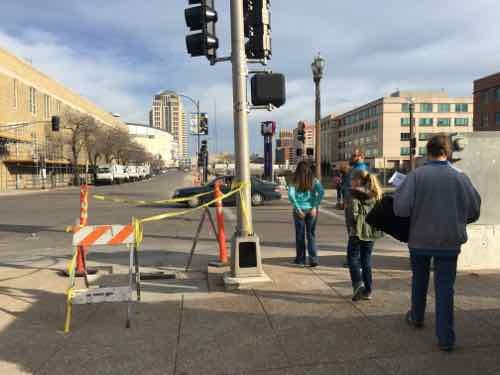
I returned again, a month later, on February 26th:
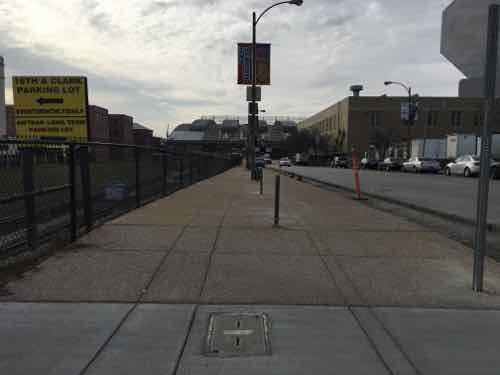
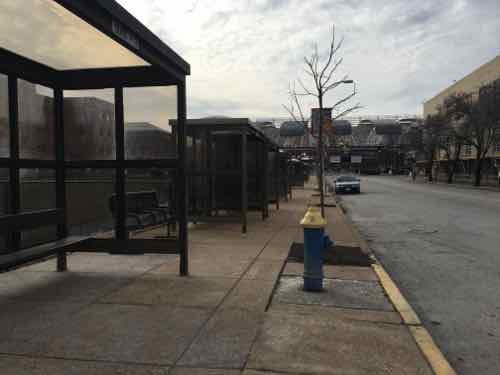
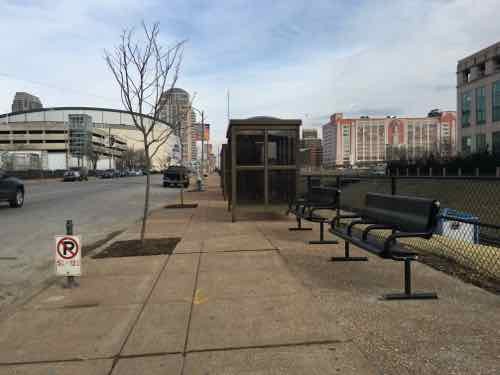
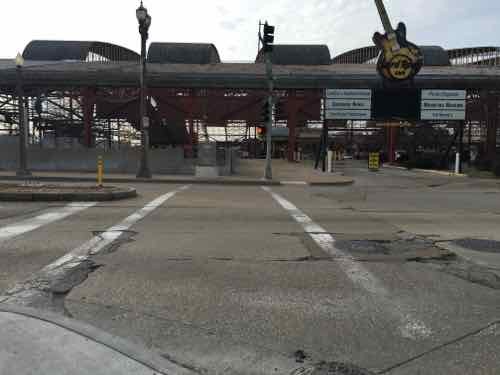
The ramp location behind the crosswalk is a head scratcher, for sure. I resisted the urge to post it to social media — opting to wait until the project is closer to completion. I even went back yesterday to see if the crosswalk had been changed. It hasn’t. I also discovered another problem: pedestrian signal location.
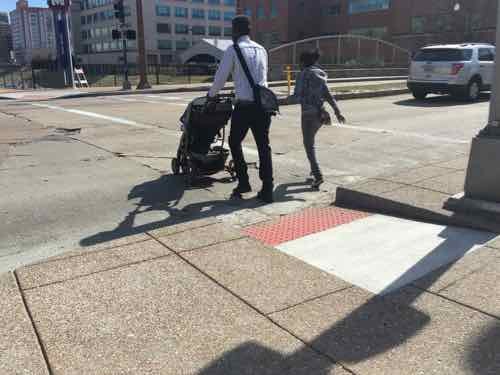
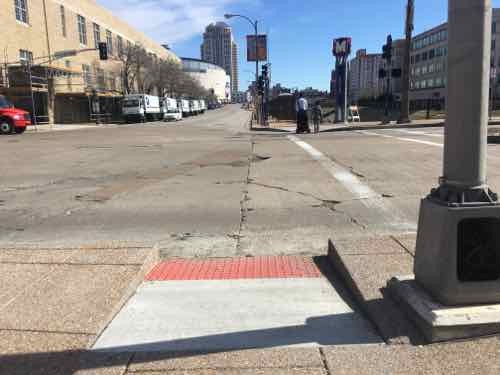
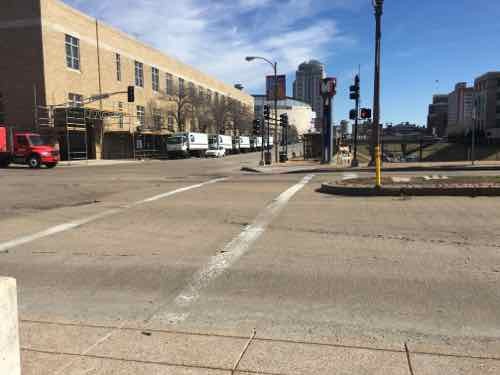
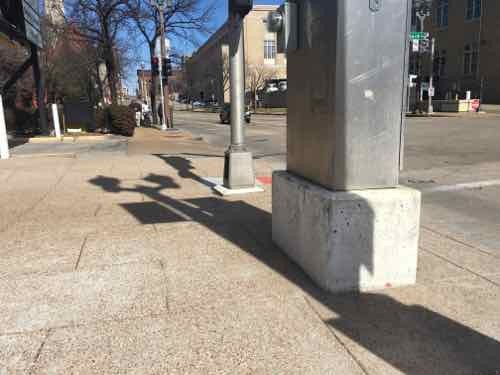
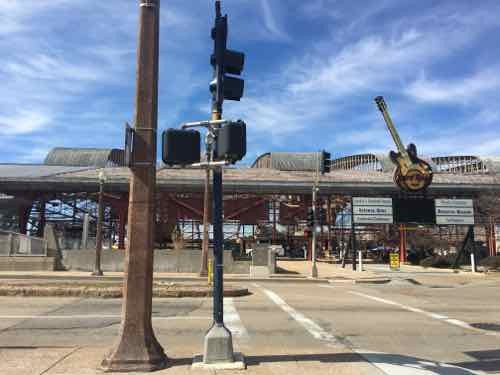
The best words that come to mind are gross incompetence. Both sides were completely opened up — all new concrete. That was the time to move pedestrian signals so they align with the crosswalk, to build the new ramps so they also align. I’m not sure if St. Louis’ new bike-pedestrian coordinator reviewed this, but other civil engineers did see it on paper. This is yet another thing making me realize I need to live in another city.
— Steve Patterson
As far as living in another city… I’m sure this kind of stuff happens all the time in other places as well. Still, it’s kinda ridiculous.
No city is perfect, but I’ve visited quite a few cities in the last 8 erasers in my wheelchair. The entire St. Louis region does a poor job compared to most.
Isn’t this more of a City issue than a Metro Transit issue?
yes. which is the problem. Street paving is controlled by the aldermen- they decide which streets in their wards are priorities for paving. That part of 18th Street is the border between the 6th (based in Compton Heights/Lafayette Sq) and the 7th (Soulard). It doesn’t really connect to the street grid in the bulk of either ward. So it gets no love. Metro did what they could, I expect, but nothing short of a lawsuit is going to make the city comply with the ADA.
The project is a Metro project, the city has failed to properly review/supervise their work in the public right-of-way.
I understand your frustration in that your personal mobility is directly affected by careful ADA planning. But at the same time, I think you may be overlooking or shortchanging the many pedestrian improvements that have been made in STL city and county over the past several years. I travel around the country way too much and make myself aware of pedestrian conditions wherever I am, although I no longer practice civil work.
For the most part, I find that most other cities in the US also have their fair share of problems, some of which existed way too long, and some that are surprises and are noticed only AFTER engineers and architects have completed a new project. In mid-February I accompanied my oldest son to San Antonio for an orchestra convention. As you know, San Antonio is a HUGE convention city, and they recently expanded their convention center. So one would expect conditions around the center to be properly upgraded to code. Yet in areas around the new and improved convention center, there are numerous flagrant accessibility conditions that make that particular city extremely difficult in which to negotiate a wheelchair. I found sidewalks with traffic light standards centered in the cross-slope, leaving 2′-6″ and smaller clearances, and I found active fire plugs and abandoned telephone standards partially blocking sidewalks, which restrict passage by both pedestrians and wheelchair users. Ramps all over the downtown area are often makeshift and misaligned, and MANY don’t comply with current standards. I’ve said it before and I’ll say it again: engineers and architects aren’t perfect, and I know of few if any clients who have unlimited resources necessary to make all things perfect, everywhere. You can and should continue your personal crusade, and you’ll continue to make improvements to create a better ped experience for everyone. I have faith and confidence in most of the engineers and architects whom I know who work on solving accessibility issues. I honestly feel that you and the engineers/architects are kissing the same pig but sometimes at opposite ends.
I was well-aware of pedestrian issues before my stroke. But in using a wheelchair I experience these differently than as an able-bodied person. Significantly greater awareness.
The issues I listed don’t just impact me — they diminish the pedestrian experience for everyone — the majority of whom are not disabled.
And those of us who don’t require one have gained a new understanding for what you and other more wheelchair-reliant St. Louisans must deal with. I appreciate it greatly.
It really shouldn’t be the epidemic it is. The people on the City side hired (or elected) to review/approve these new projects should have a complete understanding of pedestrian connections, and the confidence to deny designs that are lacking. When things like this happen, either a) the people approving it don’t know what they’re doing, or b) they’re shirking their responsibility. Neither should be expected as the norm.
I really think the way to know whether you’re living in a strong, responsible city is directly related to how little its residents have to concern themselves about it. There are a lot of people and groups in St. Louis advocating for projects, calling out shortcomings, grassroot organizing, etc. ; that community action is great, don’t get me wrong, but it’s also symptomatic of a City (and State) government unqualified or incapable of achieving base-line quality-of-life standards. And yes, common sense pedestrian crossings are one of those.
Municipal drawing reviewers are not in a position to APPROVE or REJECT designs and details–or to correct errors and omissions, whether actual or suspicioned. Imagine the liability involved with that task! It is up to the “design professional” to complete and to submit (for drawing REVIEW) a set of drawings and specifications that meet applicable codes. In the City of STL, building department officials OFTEN schedule a pre-construction meeting attended by the architects and engineers of record, various building officials, representatives of Streets and Fire Marshall’s office, etc, etc. At the meeting, generalities and guidelines are discussed, but City officials do not dissect the design. ST Louis is one of FOUR major cities in the US (that I know of) that offers this courtesy meeting. But municipal building officials are not in a position to challenge MOST design details, and so they don’t.
I’ve had plenty of details questioned and rejected over the years. Plans examiners have greater liability approving something that doesn’t comply than rejecting something they’re not sure about (or are actually wrong in their interpretation). And it begs the question of why have plan review, at all, if the reviewers aren’t looking to see if plans do comply?!
The bigger issue is that most of the pedestrian issues Steve identifies occur on the PUBLIC right of way, and the city has a responsibility, as an owner, to make continued, positive, progress in maintaining and improving its public assets. Blaming Metro, MODOT or public utilities for not doing things right is a direct, negative, reflection on the city’s ability to take care of what is THEIRS!
I knows a lot of people hold traffic engineers in low esteem, but they’re the ones that do know the rules and how they need to be applied. Unfortunately, this all boils down to money – it takes money to both do stuff and to manage stuff, and given the power of the local alderman and a thin city budget, there’s not much cash available for either people or concrete.
Not since Dr. Dee graced the halls of 12th and Market has the City had an ADA advocate who actually digs into the details during plan review, studies the conditions, figuratively walks over the sidewalks, up and down the accessible ramps, crossing streets and negotiating the curbs across the street, walks (or rolls) into and out of the buildings, through the corridors, then calling special meetings to discuss questionable issues, etc, etc. And, in the end, even after all her due diligence, if errors and omissions came to light during or post construction, the design professionals are still held responsible–as they should be. I have been doing structural work for over 10 years, and other than in Israel, where ONE WOMAN reviews all structural and architectural details for projects exceeding $15M, I have NEVER been questioned by a municipal plan reviewer on one of my details or specifications. NEVER. I typically submit my drawings and my calculations, and they’re perfunctorily stamped “REVIEWED” (vs APPROVED). And I know for certain that they are typically (if not always) rubber stamped because I’ve caught my own errors during shop drawing reviews! I worked on a hospital 5 years ago on which dead-end corridor issues came up during construction, vs during the municipal review process. Again, the architectural firm picked up the tab to correct that issue! Not the plan reviewers, who often have multiple sets of drawings piled high, cluttering their desks,
waiting to be reviewed, owners and contractors beating down their doors pressuring them to issue building permits, and who operate from the disadvantage of not having been intimately involved in the building’s development for months on end! Dr. Dee was a remarkable woman, and she obviously burned her candle at both ends in order to do her job well. Her diligence avoided multiple oversights during her reign, but that type of woman is seldom found in permitting departments across the country.
It shouldn’t take anyone special to know that a curb ramp should be within the crosswalk, or that people wanting to cross the sheet should be able to see the pedestrian signal.
You’re right. But funding is not always available to relocate existing utilities so that curb cuts can be placed exactly where they should ideally be placed. And owners are not bashful about letting us know when that’s the case!!!! And it is OFTEN the case! Or it’s just possible that, during the design phase, an engineer might have misinterpreted the orientation of a pedestrian signal, or it’s possible that the engineer was just brain dead when he was working on that particular segment. Maybe he had a bad day, or maybe his wife and he had a bad fight just before he left for work. We’re dealing with human beings here! They’re not perfect. And plan reviewers are not perfect either! The redeeming fact is that the design professional is licensed, carries E/O insurance, and if the complaint is legitimate, the correction will be made.
When an entity is working in the public right of way it needs to be done right, especially when planned for years.
The city needs to ensure everyone working in the PROW does good work. If not, they shouldn’t accept shoddy work.
It might surprise you to know that cities are sometimes participants in decisions to make adjustments that will avoid certain utility relocations that will be costly and have relatively low impact, overall. Many cities understand that they have to be team players in order to play the game in their ballpark. Otherwise, developers will go up the road to build their project. It’s a fact of life, one that compels all parties (the city, the owner and developer) to work together, to give and take–it’s called compromise. And there usually isn’t an infinite amount of money sitting in the moneybag that the developer carries around, and when it’s gone, it’s….gone. The question is, do you want the new hotel or not? And if you do, you need to sometimes compromise.
And that’s my point – the designers shouldn’t be paid, the contractors shouldn’t be paid and the final sign-offs shouldn’t be made until the work is completed in a satisfactory manner! This is standard practice in the private sector. Progress payments are made as work, duh, progresses. Final payment is made when ALL work is completed. Someone in the city obviously said, yes, this is OK, even though it’s far from perfect. Without that approval, guess what? No final payment! We don’t know if the origial design was wrong, what work was included and what was excluded, and if the contractor made substantive changes that were “approved”.
You know, cities tend to be diligent about holding final payment until all contractor punch list items have been completed and until all consultant issues have been resolved, and any unaddressed or unfinished items were probably not included either in the original or in the negotiated contract scope.
And that’s my point – this stuff, locally, continues to be “signed off”, everyone paid, and us citizens left to live with substandard work! Contractors, for the most part, do what they’re told (paid) to do – someone (in city government) ain’t tellin’ them to do the right stuff!
If my house needs tuck pointing and if my budget is limited, I’ll bid out those elevations that need it most. I’ll wait on the balance until next year.
And in defense of municipal owner-reps, I can’t say from my experience that they are typically cavalier about their responsibilities or intentionally negligent. But I have found that, for the most part, they tend to be less qualified, less experienced and have less vision than those who work in the private sector. They tend to operate at a slower pace. They may be degreed, but most are unlicensed. And some–for whatever reason– have never held a job practicing their field of study and have always held supervisory positions–which limits experience opportunities and really doesn’t serve the public well. But there are exceptions in all cities.
Metro has been planning this project for years, they also funded it. This is so they can close & redo the Civic Center MetroBus Transit Center.
So, to “fix” things, someone needs to restripe the crosswalk, somone else needs to turn the walk light, slightly, and a third person needs to relocate the pushbutton? These all seem to fall under the duties of the Streets Dept., not Metro . . .
…..and when the dust from the argument settles, the cost impact of fixing the issue is negligible.
I don’t think the cost will be negligible. And we shouldn’t need to “fix” brand new work!
The winds and waves are always on the side of the ablest navigators!
Pricing: Turn the walk light on the existing pole: 2 hours, tops. $250.00
Restripe crosswalk: 3 hours tops: $350.00 (including paint)
Sawcut pavement for undergound electrical extension and footing 1 hour, $200.00
Purchase conduit, wiring, misc. accessories $100.00
Excavation of trench and footing for new standard $200.00
Provide new standard $800.00
Pour footing and and patch trench $250.00 Set new standard and make connections $500.00
If the work is done by city employees, we’re talking $2.5K-3K.
These costs are negligible in the large scope of things.
Costs are always less when incorporated into a larger project vs coming back later to fix mistakes. Who should pay to fix this? Metro? Their contractor? Their design engineer? The city?
If the city has accepted the work then likely the city will be responsible — the cost of not bing diligent earlier.
And no, turning “the walk light on the existing pole” isn’t an option because that’s too far away from the crosswalk to meet standards:, ” Pedestrian signal heads shall be mounted with the bottom of the signal housing including brackets not less than 7 feet or more than 10 feet above sidewalk level, and shall be positioned and adjusted to provide maximum visibility at the beginning of the controlled crosswalk.” http://mutcd.fhwa.dot.gov/htm/2009/part4/part4e.htm
Can the walk light remain at its current elevation, if it is merely rotated to the proper orientation? I would assume that the walk light is now mounted somewhere between 7′ and 10′ above finished pavement. There’s a 3′ window described in the regulation…lots of distance there….so I’m fairly certain some plausible options are open. And whenever I come across a regulation that reads, “to provide maximum” anything, I know for certain that subjectivity has been introduced into the regulation and that there’s potential for a reasonable solution to the issue, provided all parties want a reasonable solution. Unless defined elsewhere in the regulation, “maximum visibility” is nebulous and open to interpretation.
Whoever designed the intersection is responsible for any errors or omissions in the design–subject, of course, to any qualifications contained in the original RFP or any contract scope executed by change order.
I didn’t measure the height — that was just part of the relevant section. Way off to the right isn’t maximum visibility. I can’t find it but I believe there’s a definition that would limit the number of degrees from center.
It isn’t incumbent upon the City to be diligent in this case. It’s not up to the City to “catch” their consultant’s engineering errors. If substantial changes weren’t made to the intersection after it was turned over to the City, and if the engineer’s design violates codes or ordinances, then the engineer will have to open his pocket book.
If someone is doing work at your house — say the electric utility hires a landscaper to trim trees. Wouldn’t you as the property owner be concerned about the quality of their work and want them to do it right the first time — not need to come back and fix mistakes later?
When you “own” thousands of street corners, you would expect the city to have, or have developed, some expertise and some enforeceable standards for their properties!
Absolutely. But I know that tree trimmers don’t always “get it right”, and architects and engineers don’t as well, just like the car manufacturers and the toaster maker, the floor tile manufacturer, etc. And when it’s wrong, I’ll be the first one to fight like hell until the responsible party makes it right. But these things don’t always happen the first time around.
While traffic fatalities, in general, continue to drop, pedestrian fatalities are headed in the opposite direction: http://jalopnik.com/pedestrian-deaths-are-rising-at-a-terrifying-rate-1763557608 . . Should we blame poor design, poor infrastructure or changing behaviors (and not for the better) on the part of pedestrians?!